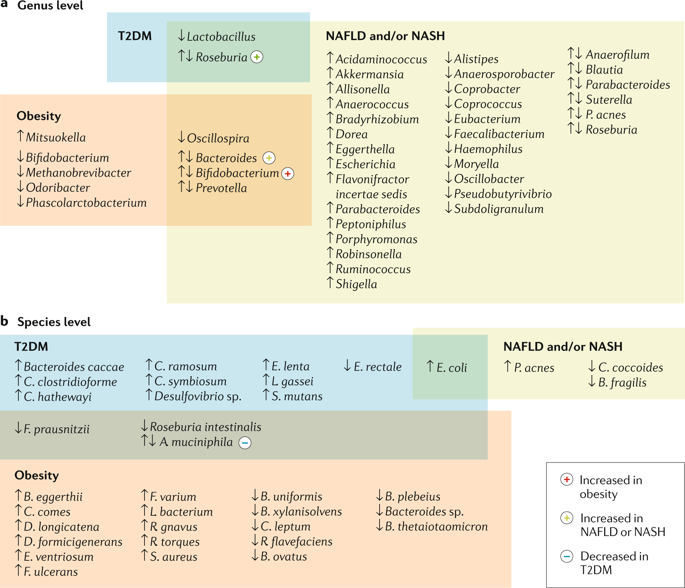当前位置:
X-MOL 学术
›
Nat. Rev. Gastroenterol. Hepatol.
›
论文详情
Our official English website, www.x-mol.net, welcomes your
feedback! (Note: you will need to create a separate account there.)
Gut microbiota and human NAFLD: disentangling microbial signatures from metabolic disorders.
Nature Reviews Gastroenterology & Hepatology ( IF 45.9 ) Pub Date : 2020-03-09 , DOI: 10.1038/s41575-020-0269-9 Judith Aron-Wisnewsky 1, 2, 3 , Chloé Vigliotti 1, 4 , Julia Witjes 3 , Phuong Le 1, 4 , Adriaan G Holleboom 3 , Joanne Verheij 5 , Max Nieuwdorp 3, 6 , Karine Clément 1, 2
Nature Reviews Gastroenterology & Hepatology ( IF 45.9 ) Pub Date : 2020-03-09 , DOI: 10.1038/s41575-020-0269-9 Judith Aron-Wisnewsky 1, 2, 3 , Chloé Vigliotti 1, 4 , Julia Witjes 3 , Phuong Le 1, 4 , Adriaan G Holleboom 3 , Joanne Verheij 5 , Max Nieuwdorp 3, 6 , Karine Clément 1, 2
Affiliation

|
Gut microbiota dysbiosis has been repeatedly observed in obesity and type 2 diabetes mellitus, two metabolic diseases strongly intertwined with non-alcoholic fatty liver disease (NAFLD). Animal studies have demonstrated a potential causal role of gut microbiota in NAFLD. Human studies have started to describe microbiota alterations in NAFLD and have found a few consistent microbiome signatures discriminating healthy individuals from those with NAFLD, non-alcoholic steatohepatitis or cirrhosis. However, patients with NAFLD often present with obesity and/or insulin resistance and type 2 diabetes mellitus, and these metabolic confounding factors for dysbiosis have not always been considered. Patients with different NAFLD severity stages often present with heterogeneous lesions and variable demographic characteristics (including age, sex and ethnicity), which are known to affect the gut microbiome and have been overlooked in most studies. Finally, multiple gut microbiome sequencing tools and NAFLD diagnostic methods have been used across studies that could account for discrepant microbiome signatures. This Review provides a broad insight into microbiome signatures for human NAFLD and explores issues with disentangling these signatures from underlying metabolic disorders. More advanced metagenomics and multi-omics studies using system biology approaches are needed to improve microbiome biomarkers.
中文翻译:

肠道菌群和人类NAFLD:从代谢紊乱中分离出微生物特征。
在肥胖症和2型糖尿病(这两种代谢性疾病与非酒精性脂肪肝疾病(NAFLD)密切相关)中反复观察到肠道菌群失调。动物研究表明,肠道菌群在NAFLD中具有潜在的因果作用。人体研究已开始描述NAFLD中的微生物群改变,并发现了一些一致的微生物组特征,可将健康个体与NAFLD,非酒精性脂肪性肝炎或肝硬化患者区分开。然而,患有NAFLD的患者经常表现为肥胖和/或胰岛素抵抗以及2型糖尿病,并且这些代谢紊乱的代谢混杂因素并不总是被考虑。NAFLD严重程度不同的患者通常表现出异质性病变和不同的人口统计学特征(包括年龄,性别和种族),已知会影响肠道微生物组,并且在大多数研究中都被忽略。最后,在研究中使用了多种肠道微生物组测序工具和NAFLD诊断方法,可以解释不同的微生物组特征。这篇综述为人类NAFLD的微生物组特征提供了广泛的见解,并探讨了将这些特征与潜在的代谢紊乱区分开的问题。需要使用系统生物学方法进行更高级的宏基因组学和多组学研究,以改善微生物组生物标志物。这篇综述为人类NAFLD的微生物组特征提供了广泛的见解,并探讨了将这些特征与潜在的代谢紊乱区分开的问题。需要使用系统生物学方法进行更高级的宏基因组学和多组学研究,以改善微生物组生物标志物。这篇综述为人类NAFLD的微生物组特征提供了广泛的见解,并探讨了将这些特征与潜在的代谢紊乱区分开的问题。需要使用系统生物学方法进行更高级的宏基因组学和多组学研究,以改善微生物组生物标志物。
更新日期:2020-03-09
中文翻译:

肠道菌群和人类NAFLD:从代谢紊乱中分离出微生物特征。
在肥胖症和2型糖尿病(这两种代谢性疾病与非酒精性脂肪肝疾病(NAFLD)密切相关)中反复观察到肠道菌群失调。动物研究表明,肠道菌群在NAFLD中具有潜在的因果作用。人体研究已开始描述NAFLD中的微生物群改变,并发现了一些一致的微生物组特征,可将健康个体与NAFLD,非酒精性脂肪性肝炎或肝硬化患者区分开。然而,患有NAFLD的患者经常表现为肥胖和/或胰岛素抵抗以及2型糖尿病,并且这些代谢紊乱的代谢混杂因素并不总是被考虑。NAFLD严重程度不同的患者通常表现出异质性病变和不同的人口统计学特征(包括年龄,性别和种族),已知会影响肠道微生物组,并且在大多数研究中都被忽略。最后,在研究中使用了多种肠道微生物组测序工具和NAFLD诊断方法,可以解释不同的微生物组特征。这篇综述为人类NAFLD的微生物组特征提供了广泛的见解,并探讨了将这些特征与潜在的代谢紊乱区分开的问题。需要使用系统生物学方法进行更高级的宏基因组学和多组学研究,以改善微生物组生物标志物。这篇综述为人类NAFLD的微生物组特征提供了广泛的见解,并探讨了将这些特征与潜在的代谢紊乱区分开的问题。需要使用系统生物学方法进行更高级的宏基因组学和多组学研究,以改善微生物组生物标志物。这篇综述为人类NAFLD的微生物组特征提供了广泛的见解,并探讨了将这些特征与潜在的代谢紊乱区分开的问题。需要使用系统生物学方法进行更高级的宏基因组学和多组学研究,以改善微生物组生物标志物。











































 京公网安备 11010802027423号
京公网安备 11010802027423号